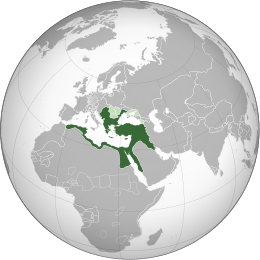More languages
More actions
| Ottoman Empire دولت عليه عثمانیه | |
|---|---|
| 1299–1922 | |
 The empire at its peak in 1683 with vassal states in light green | |
| Capital | Istanbul |
| Dominant mode of production | Feudalism (Semi-colonial after 1857) |
| Government | Monarchy |
| Area | |
• Total | 5,200,000 km² |
| Population | |
• 1912 estimate | 24,000,000 |
The Ottoman Empire was a state based in Western Asia that also controlled parts of Southeast Europe, and Northern Africa. It was an absolute monarchy under a sultan and other government officials. Its army used muskets and cannons and included professional soldiers and landowners similar to European knights.[1]
History[edit | edit source]
Early history[edit | edit source]
A Turkish warlord founded the Ottoman Empire in Anatolia the 14th century. It captured the Byzantine capital of Constantinople in 1453 and then expanded into the Balkans, North Africa, and the coasts of the Red Sea and Persian Gulf.[1] There were some peasant rebellions in the Ottoman Empire, the most famous of these was the religious and pro-equality[2] Sheikh Bedreddin Rebellion in the 15th century. There were also nomadic rebellions in Anatolia, often led by Shiite Turkmen tribes.
Crimean War[edit | edit source]
Britain and France supported the Ottoman Empire in the Crimean War from 1853 to 1856 to stop southward Russian expansion. After the war, the Ottoman Empire became a semi-colony of France and the UK and relied on their loans to fund railways and weaponry. The late empire spent 30% of its budget on interest payments to foreign banks.[1]
Young Turk revolution[edit | edit source]
Armenians in eastern Turkey revolted following the 1905 revolution in Russia. By the time the Ottomans granted amnesty to the Armenians and cancelled their taxes, the rebellion had spread to other parts of the empire. Junior army officers in the Balkans formed an underground opposition network called the Committee of Union and Progress, commonly known as the Young Turks, which consisted mostly of liberal bourgeois nationalists.
In July 1908, the CUP leader Enver Pasha restored the 1876 Constitution, causing massive revolt across the Balkans and forcing Sultan Abdul Hamid Osman to call parliamentary elections. Religious conservatives attempted a counterrevolution in 1909 with the Sultan's support and massacred 17,000 Armenians in Adana. The CUP soon crushed the counterrevolution and overthrew the Sultan.
From 1911 until its collapse, the Ottoman Empire broke apart in a series of wars, losing Libya in 1912 and Macedonia. In 1913, three CUP leaders overthrew the constitutional government to create a three-man dictatorship and formed a secret military alliance with Germany. The CUP began to support pan-Turkic nationalism and increased oppression of non-Turkic peoples in the empire while also repressing the proletariat and peasantry.[1]
First World War[edit | edit source]
When the First World War broke out in 1914, the Ottomans sided with the Central powers, and when their side lost the war in 1918 the British, and French took the opportunity to dismantle the empire and claim its territories for their own spheres of influence. In 1916 the British, and French signed the secret Sykes–Picot Agreement, a plan to divide up the territories of the empire between themselves, and when the war ended this treaty was the basis for what Western Asia would become after the fall of the Ottoman Empire.[3]
Government[edit | edit source]
Ottoman society in both urban and rural areas was divided into ethnic groups called millets.[1]
References[edit | edit source]
- ↑ 1.0 1.1 1.2 1.3 1.4 Neil Faulkner (2013). A Marxist History of the World: From Neanderthals to Neoliberals: 'Imperialism and War' (pp. 180–182). [PDF] Pluto Press. ISBN 9781849648639 [LG]
- ↑ Sungur Savran (2016-12-26). "Sheikh Bedreddin: A Greco-Turkish Communist Internationalist Avant la Lettre" Socialist Project.
- ↑ "A century on: Why Arabs resent Sykes-Picot". Al Jazeera. Retrieved 2024-01-20.


